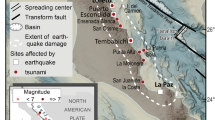Abstract
Topographic data from the Shuttle Radar Topography Mission (SRTM) captures the permanent deformation of a prominent highstand of Mono Lake, California USA. Deformation of the Dechambeau Ranch highstand shoreline was measured using the elevation of the beach berm—shoreline bluff break-in-slope. Point source models and a boundary element dike model were used to approximate the source of deformation underneath the northern end of the Mono Craters. The point source model could not adequately explain the observed deformation. The dike model yielded the best results for a NW trending dike dipping 60° NE and inflated to widths greater than 60 m. The results suggest that the geometry of the source is more complex than a simple vertical dike and that the deformation is better explained with a dipping dike following a normal fault, or an elongated cryptodome.










Similar content being viewed by others
References
Bailey RA (1989) Geologic map of long Valley Caldera, Mono—Inyo Craters volcanic chain, and vicinity, Eastern California, US Geol Surv Misc Invest Map I-1933, Scale 1:62, 500
Bursik M (1993) Subplinian eruption mechanisms inferred from volatile and clast dispersal data. J Volcanol Geotherm Res 57:57–70
Bursik M, Sieh K (1989) Range front faulting and volcanism in the Mono Basin, Eastern California. J Geophys Res 94:15587–15609
Bursik M, Renshaw C, McCalpin J, Berry M (2003) A volcanotectonic cascade: activation of range front faulting and eruptions by dike intrusion, Mono Basin-Long Valley Caldera, California. J Geophys Res 108:2393–2407
Comninou MA, Dunders J (1975) The angular dislocation in a half-space. J Elastic 5:203–216
Dieterich JH, Decker RW (1975) Finite element modeling of surface deformation associated with volcanism. J Geophys Res 80:4094–4102
Griffin K (1998) Poly3D: a tutorial-base users’ manual for Poly3D. 59p. http://www.geo.umass.edu/faculty/cooke/poly3d/polyIntro.pdf (accessed 9 March 2010)
Mogi K (1958) Relations of the eruptions of various volcanoes and the deformations of the ground surfaces around them. Bull Earthq Res Inst Univ Tokyo 36:99–134
Newman S, Epstein S, Stolper E (1988) Water, carbon dioxide, and hydrogen isotopes in glasses from the c 1340 AD eruption of Mono Craters, California: cnstraints on degassing phenomena and initial volatile content. J Volcanol Geotherm Res 35:75–96
Pakiser LC (1976) Seismic exploration of Mono Basin, California. J Geophys Res 81:3607–3618
Pollard DD, Holzhausen G (1979) On the mechanical interaction between a fluid-filled fracture and the earth’s surface. Tectonophysics 53:27–57
Reheis MC, Stine S, Sarna-Wojcicki AM (2002) Drainage reversals in Mono Basin during the late Pliocene and Pleistocene. Geol Soc Am Bull 114:991–1006
Segall P, Pollard DD (1980) Mechanics of discontinuous faults. J Geophys Res 85:4337–4350
Shaffer W (2006) Evaluation of the Shuttle Radar Topography Mission Digital Elevation Model and application to the modeling of permanent deformation: case studies on the North Mono eruption, California (1325–1368 AD) and glacial Lake Iroquois, New York (12,200 yr BP). MS thesis, University at Buffalo
Sieh K, Bursik M (1986) Most recent eruption of the Mono Craters, Eastern Central California. J Geophys Res 91:12539–12571
Stine SW (1987) Mono Lake: the past 4,000 years. PhD thesis, University of California
Thomas AL (1993) Poly3D: a three-dimensional, polygonal element, displacement discontinuity boundary element computer program with applications to fractures, faults, and cavities in the Earth’s crust. MS thesis, Stanford University
Thomas AL, Pollard DD (1993) The geometry of echelon fractures in rock: implications from laboratory and numerical experiments. J Struct Geol 15:323–334
Acknowledgments
This work was supported primarily by NASA grants NAG534142 and NNX08AF75G to study use of SRTM data in modeling volcanic phenomena. Funding from USGS 9ARRAV0030 was helpful in finalizing the work. The suggestions of reviewer Juan Manuel Espindola-C. and an anonymous reviewer are greatly appreciated.
Author information
Authors and Affiliations
Corresponding author
Additional information
Editorial responsibility: H. Delgado
Rights and permissions
About this article
Cite this article
Shaffer, W., Bursik, M. & Renshaw, C. Elastic source model of the North Mono eruption (1325–1368 A.D.) based on shoreline deformation. Bull Volcanol 72, 1141–1152 (2010). https://doi.org/10.1007/s00445-010-0385-4
Received:
Accepted:
Published:
Issue Date:
DOI: https://doi.org/10.1007/s00445-010-0385-4




